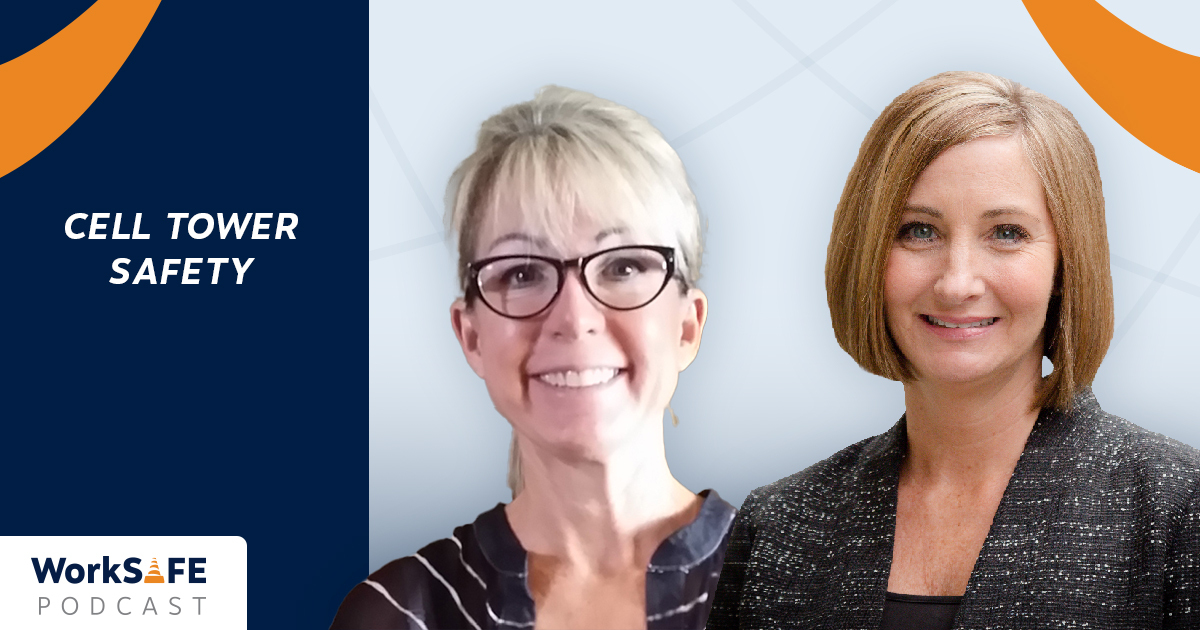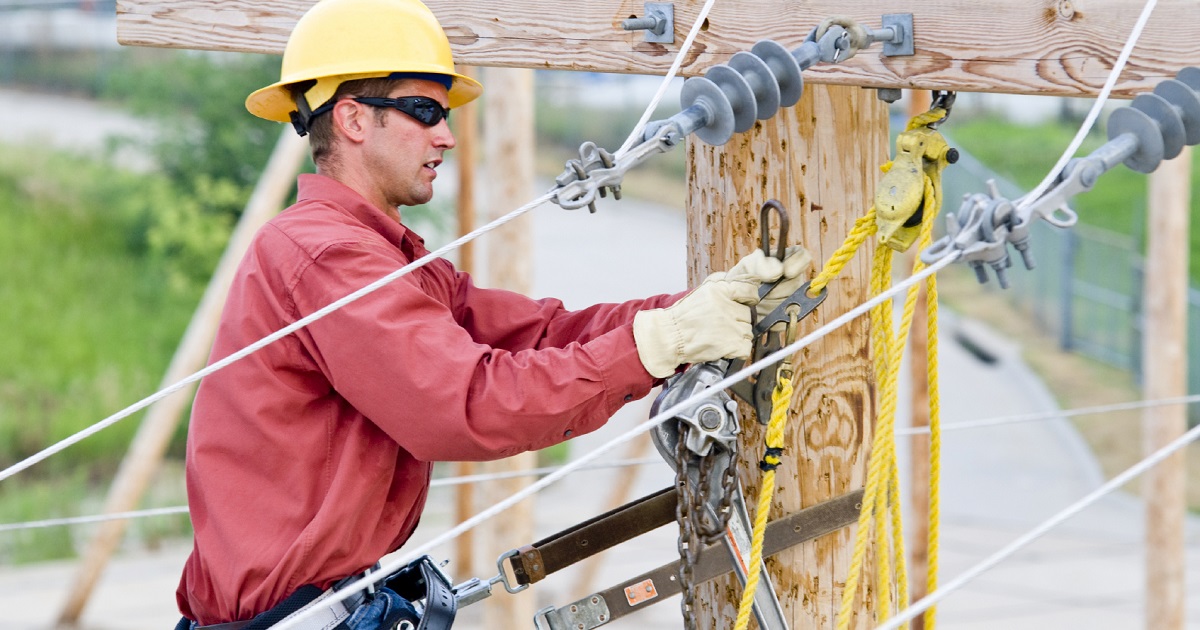For Media Inquiries
Contact Revee White, Director of Marketing and Communications at rwhite1@mem-ins.com or 573.499.4190.
In today’s workforce, there are many occupations that are taken for granted. High up on list would be those that work at heights. We drive or walk past towers so often that they feel like part of city scenery. However, these sky-high sites have a vital role. They keep us connected to one another through important networks: cellphones, radios and power grids. Tower climbing is needed to maintain them – and a select few take on the challenge.
On this episode of the WorkSAFE Podcast, we sit down with Kathy Gill. She is the owner of Tower Safety. Her team uses their extensive knowledge of rigging, climbing, rescue and installation to train and educate others. Their work enables employees to return home safely every day.
First, we’ll talk about how Gill filled an important gap in tower climbing safety training. Then, we’ll discuss the most common three risks tower crews face on the job. Finally, we’ll share what tower climbers need to be successful on the job – and some resources that can help them.
Listen to this episode on the WorkSAFE Podcast, or read the show notes below.
Tower climbing: Filling a gap in safety training
For Gill, the journey into tower safety began during her time in the construction industry. She owned a company with her late husband, running wireless crews. Their work required safety training. However, the class Gill attended didn’t quite go as expected. “I received something some of the worst training,” she explained. “Everything was done so fast I really didn’t comprehend everything. So I’m like, if this is the quality the guys are getting, then this is not good for our industry.”
Poor training would put not just Gill’s employees at risk, but other tower climbers, too. So she invested a year into opening a safety school, writing and preparing educational materials and training spaces. Today at Tower Safety, employees can train in a variety of environments. This includes different types of cell towers, confined spaces and a water tank. Better training doesn’t just make employees safer – it also makes them more confident. “The more knowledge people have, the better you become right? The better your job is.”
Fall protection is a priority
Many safety risks that come with maintaining towers cross over into other industries. For example, working with electrical lines means following one set of safety standards. Working with wind turbines has a different set. Even firefighters, who often work at heights, have another. But on any tower climbing job, fall arrest and fall protection systems are a priority. It’s the common thread between all industries that work at heights of over six feet.
These systems save lives, and Gill is strict about their use in training. Many incidents happen when employees take their fall protection systems off. Called ‘free climbing’, huge risks occur when someone disconnects themselves from their safety system. Newer employees commonly forget how to reattach their lines. More seasoned workers may simply get complacent. It may only be for a moment, but it only takes a second to change a life forever.
Gill implements what she calls ‘the rule of three’. Trainees get very little room to make the mistake of removing fall arrest lines. “Like baseball, if I have to tell you three times, then you will not be able to pass this course,” she explained. “If you cannot remember to keep your fall rest on, then we need to get you back into some more training. This is the most important thing when you’re at height.”
Tower climbing: 3 major risks
Working in telecommunications can be surprisingly demanding. Crews can go for days with packed schedules, and then days without anything. A call for maintenance or installation can come at any time. Employees must rely on each other – and work as a team – to ensure they stay safe.
“There’s a really good brotherhood with these men, where they travel in the groups of you know, two to four teams that they actually become like family,” Gill said. “They they room together. They’re driving together. They’re on the road together for three to six weeks at a time.” However, if falls are at the top of the tower climbing risk list, rigging comes in a close second place, followed by weather-related stress and nature itself.
Rigging
Rigging is a system of ropes, winches and pulleys that allow crews to bring tools and other important parts up to the right working height. Even on seemingly simple jobs, these items can weigh up to 350 pounds. A wrong move can result in dropped tools, or even lost fingers.
Working around it presents a challenge. “There’s lots of issues that come into rigging,” Gill shared. “Gravity doesn’t care. Whenever we lift, gravity is pulling down.” Add in high wind speeds and angles needed to create enough space to work; employees are battling unseen forces from all directions. “If you’re not skilled and knowledgeable in rigging, much can go wrong very quickly.”
Heat and cold stress
A major, unseen element of tower climbing is waiting. While crews install equipment, they also must make sure it’s operational. This means waiting, sometimes for hours at a time. Gill has even seen this process, called integration, take two to three days. As a result, this means everything happens at height, from lunch breaks to bathroom breaks. “Usually the ground crew will haul up their water for them or what they need,” Gill said. “Sometimes you’ll see posts on Facebook – they’re hauling up pizza for the guys.”
In the summer months, excess time in hot weather puts them at risk of dehydration and heat stress. Employees must be not only trained for their job, but also in how to rescue coworkers in distress. Depending on the size of the team, crews can help rescue each other. “The bond is huge in our industry. I guess like other industries, you develop that brotherhood, or sisterhood, of just looking out for one another.”
While Gill is based in the southwest, she acknowledges the struggle of crews that work in the north. Frosty wind and low temperatures create a different kind of hazard. “There is that need to make sure that the men are taken care of up in the air,” she added. “You look at Montana, Canada – minus twenty, thirty below – that’s crazy! We’re in Arizona so I can’t imagine what minus twenty feels like.”
Natural elements
Working outside means fending off the natural elements. While weather is often the first thing to come to mind, there are other unexpected – and unpleasant – surprises. Snakes and spiders make their home in some towers. Wasps and bees stake their claim in others. Dodging birds, and their poop, is another hazard of the job. And unfortunately, sometimes nature wins out. Some critters, especially birds, can’t be disturbed. “There a lot of them. Many of them are federally protected,” Gill mused. “But birds make a very nasty mess all over the tower.”
Confidence is key
It takes a unique personality to want to work at heights. Gill points out the job comes with many challenges: unpredictable conditions, long hours and stretches of time away from home. However, with the right training and preparation, any employee can be made ready for the job. In addition to the right training, employees also need to:
- Practice good communication. Staying in touch with team members while on the job is essential. Crew members need to communicate their status whether they are on the job or getting ready to perform a rescue.
- Mental preparedness. Employees need to have self-confidence. When they arrive a job site, they should feel they have the skills they need and be ready to work. This confidence comes from plenty of practice.
Training and practice come together in a special event Gill created called the Tower Rodeo Challenge. The two-day event meets both OSHA and ANSI rescue practice requirements. Teams come together to train, practice and compete. Each realistic scenario helps educate and train crews – and prepare them for what they might encounter on the job.
In today’s world of technology and communication, tower climbing can’t be taken for granted. Crews work hundreds of feet in the air, enabling us to call, text and tune in to the latest television shows. “I appreciate being able to talk about it, and let everybody know what these men and women do to make sure our cell phones work,” Gill finished.
For more information on Gill’s training school and courses, visit the Tower Safety website. Free resources are available in our Resource Library. Then, discover more about working safely at height on this episode of the WorkSAFE Podcast.

